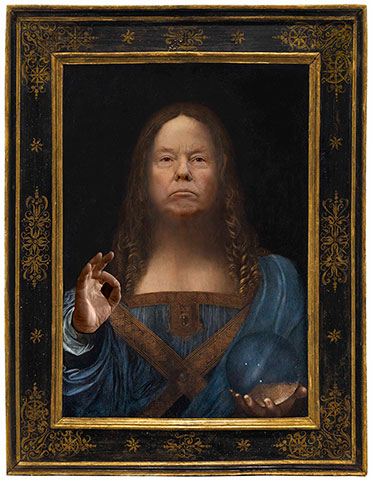NEW YORK – Salvator Mundi, said to be by Leonardo da Vinci, is the world’s most expensive painting.
Last Wednesday, at auction, each square inch was valued at nearly $1 million – including the bummed-up, restored, and damaged parts.
The painting may not be da Vinci’s work. Or perhaps, since it has been so heavily doctored up, little remains of his work. And whoever’s work it was must have been having a bad day.
And yet, it sold for over $450 million (including auction-house charges) – a lot of money for such a depressing work of art.

Donald Trump as da Vinci’s Salvator Mundi
The question on the table: Why?
But since we don’t know the answer to that question, we’ll answer another one: How come so many people have so much money?
Made in the Middle
The latest GOP “tax reform” proposals raise questions, too.
Though billed as a “middle-class tax cut,” the middle class gets almost nothing from the proposed plan.
Instead, almost all the benefits go to: (1) business owners, and (2) the rich.
And since the feds are unwilling to cut spending, the middle class ends up with about $2.2 trillion of extra debt, which it will have to reckon with eventually.
We bring up the tax cut because we think it helps explain the painting. Not for nothing are Republicans and the modern Salvator Himself, Donald J. Trump, setting up the middle class for a huge bamboozle.
Our train ride yesterday – the Acela Express from Baltimore to New York – was subsidized by taxpayers from all over the country.
The train runs from one end of today’s modern economy to the other. It goes from Washington, D.C. – the center of politics – to New York – the center of money.
In between is nothing but poverty and dereliction. There are factories that last made a product in the ’50s. There are workers’ houses almost unchanged in half a century. There are abandoned warehouses… wrecked cars… junk steel… and burly men in orange vests working with machines.
The middle is where real work was done and real things were made, shipped, and distributed; it shows few signs of growth or prosperity.
It is as though a sausage had been squeezed in the middle, driving the rich meat to the ends. In between is lean… and greasy.
How come?
Deep State’s Fingerprints
Every crime scene has many fingerprints on it.
Most are of the innocent.
An aging population, for example, is not exactly something you can do anything about. Technological innovations, too, are largely beyond public policy control.
But there’s one set of fingerprints on the tax cut flimflam… the relative poverty along the Northeast Corridor… and the $450 million painting: the Deep State’s.
The insiders use fake money – the post-1971 dollar – to transfer wealth and power from the people who earn it to themselves. It is as though they loaded up the train in Newark and Trenton… and shipped everything to Washington.
You earn real money by making real things and providing real services. But fake money is different. You don’t earn it by adding to the world’s wealth.
You get it by subtracting from it… that is, by borrowing from future output.
Real money is not controlled by anyone. It is earned – freely – in win-win exchanges. Back in the 1950s and 1960s, it ended up in places like East Baltimore and Trenton because they used to make things people wanted.
But fake money takes a different route. It is created by the insiders… and controlled by them. It goes where they want it to go.
No Stimulus
Money always bows to politics; often, it is completely beholden to it.
In Russia, the oligarchs took government-owned property and used it to build their fortunes. In China, state-owned enterprises and favored entrepreneurs get government-backed credit to build their apartments, factories, and shopping malls.
And in America, the fake money is directed to favored sectors by 73,000 pages of the Internal Revenue Code… and 81,000 pages of the Federal Register.
So, it is hardly a surprise that the latest tax proposals favor the Deep State at the expense of the middle class.
Readers may argue that the money “stimulates” the economy… and that it “trickles down” to the common people. If so, there is little evidence of it.
As a percentage of the working-age population, fewer people have jobs today than at any time since the 1970s. Back then, the typical man had to work 900 hours to earn enough to buy a new pickup truck. Today, he has to work 1,500 hours.
Central banks have increased the world’s monetary base (and their own balance sheets) by $20 trillion so far this century.
This money didn’t go to the fellow in the orange vest. Instead, it went to Russian tycoons… Chinese billionaires… art collectors… hedge fund managers… and rich people on both ends of the track.
Regards,
![]()
Bill
Related Articles:
Category: Economics

